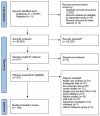Occupational Risk Factors for Burnout Syndrome Among Healthcare Professionals: A Global Systematic Review and Meta-Analysis
- PMID: 39767426
- PMCID: PMC11675210
- DOI: 10.3390/ijerph21121583
Occupational Risk Factors for Burnout Syndrome Among Healthcare Professionals: A Global Systematic Review and Meta-Analysis
Abstract
Health professionals are disproportionately affected by burnout compared to other occupational groups. This study aims to systematically review and meta-analyze thirteen occupational risk factors related to burnout syndrome among health professionals globally. A comprehensive literature search was conducted in August 2023. The protocol was registered in The International Prospective Register of Systematic Reviews (PROSPERO), registration number CRD42023396081. Using a random-effects model, this meta-analysis assessed the association between occupational risk factors and burnout, reporting odds ratios (ORs) and 95% confidence intervals (CIs). The meta-analysis included 109 studies from diverse global locations. Key factors influencing burnout included workplace bullying, job stress, and poor communication, with protective factors such as supportive work environments, adequate staffing, and individual resilience. All risk factors examined showed a significant positive relationship with burnout incidence. Workplace bullying was strongly associated with increased burnout (OR 4.05-15.01, p < 0.001). Similarly, low job satisfaction and high job stress were strongly associated with burnout, with ORs of 5.05 (95% CI 3.88-6.56, p < 0.001) and 4.21 (95% CI 1.62-10.94, p = 0.003), respectively. The review findings highlight the importance of addressing these risk factors through enhanced supportive work environments and promoting personal resilience strategies.
Keywords: burnout syndrome; health professionals; meta-analysis; occupational risk factors; systematic review.
Conflict of interest statement
The authors declare no conflicts of interest.
Figures










References
-
- World Health Organazation Burn-Out an “Occupational Phenomenon”: International Classification of Diseases. 2019. [(accessed on 11 August 2024)]. Available online: https://www.who.int/news/item/28-05-2019-burn-out-an-occupational-phenom....
-
- Maslach C., Jackson S., Leiter M. Evaluating Stress: A Book of Resources. Volume 3. The Scarecrow Press; Lanham, MD, USA: 1997. The Maslach Burnout Inventory Manual; pp. 191–218.
-
- Yazici M.U., Teksam O., Agin H., Erkek N., Arslankoylu A.E., Akca H., Esen F., Derinoz O., Yener N., Kilinc M.A., et al. The Burden of Burnout Syndrome in Pediatric Intensive Care Unit and Pediatric Emergency Department: A Multicenter Evaluation. Pediatr. Emerg. Care. 2021;37:e955–e961. doi: 10.1097/PEC.0000000000001839. - DOI - PubMed
-
- Al-Haddad A., Al-Omar F., Al-Khaleel A., Al-Khalaf A. Prevalence of burnout syndrome and its related risk factors among physicians working in primary health care centers of the Ministry of Health, Al Ahsa region, Saudi Arabia, 2018–2019. J. Fam. Med. Prim. Care. 2020;9:571–579. doi: 10.4103/jfmpc.jfmpc_743_19. - DOI - PMC - PubMed
Publication types
MeSH terms
LinkOut - more resources
Full Text Sources

